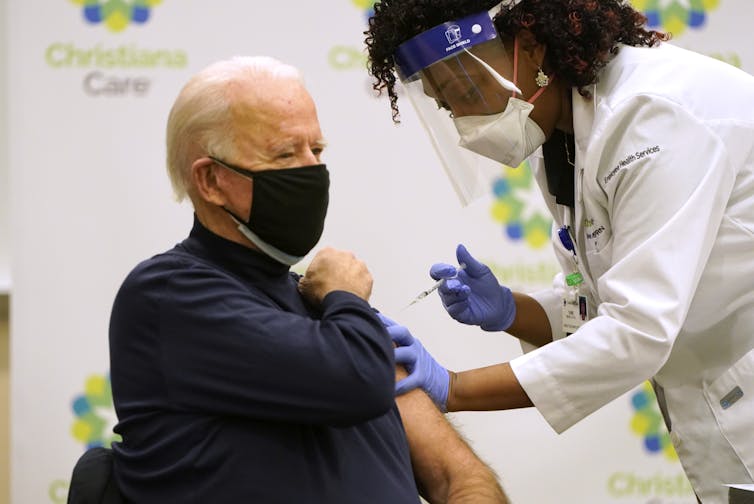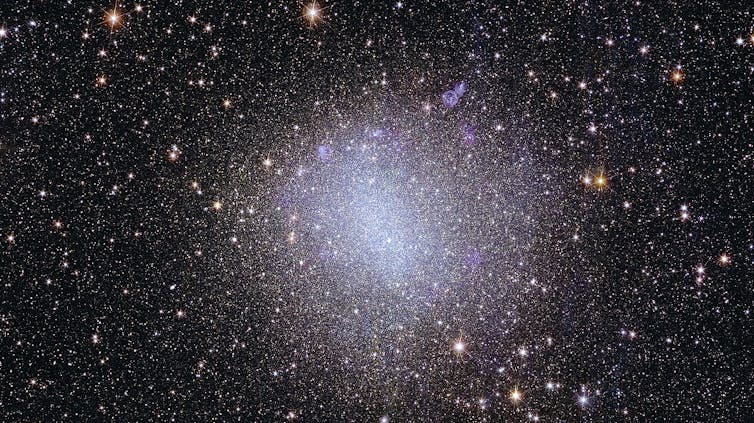Massive support for U.S. computer chip manufacturing will be part of Joe Biden’s tech legacy.
Mark Zachary Taylor, Georgia Institute of Technology
In evaluating the outgoing Biden administration, much news has focused on inflation, immigration or Hunter’s laptop. But as an expert on national competitiveness in science and technology, I have a somewhat different emphasis. My research shows that U.S. prosperity and security depend heavily on the country’s ability to produce cutting-edge science and tech.
So, how did the Biden administration perform along these lines?
Advancing pandemic science and tech
President Joe Biden’s immediate challenge after inauguration was to end the COVID-19 pandemic and then shift the economy back to normal operations.
First, he threw the weight of his administration behind vaccine production and distribution. Thanks to President Donald Trump’s Operation Warp Speed, inoculations had begun mid-December 2020. But there had been no national rollout, and no plans existed for one. When Biden took office, only about 5% of Americans had been vaccinated.
Biden set an example by getting his own COVID-19 vaccinations.
The Biden administration collaborated with private retail chains to build up cold storage and distribution capacity. To ensure adequate vaccine supply, Biden worked to support the major pharmaceutical manufacturers. And throughout, Biden conducted a public relations campaign to inform, educate and motivate Americans to get vaccinated.
Within the first 10 weeks of Biden’s presidency, one-third of the U.S. population had received at least one dose, half by the end of May, and over 70% by year’s end. And as Americans got vaccinated, travel bans were lifted, schools came back into session, and business gradually returned to normal.
A later study found that Biden’s vaccination program prevented more than 3.2 million American deaths and 18.5 million hospitalizations, and saved US$1.15 trillion in medical costs and lost economic output.
In the wake of the economic distress caused by the COVID-19 pandemic, Biden signed two bills with direct and widespread impacts on science and technology. Previous administrations had promised infrastructure investments, but Biden delivered. The Infrastructure Investment and Jobs Act, passed with bipartisan support during late 2021, provided $1.2 trillion for infrastructure of all types.
Rather than just rebuilding, the act prioritized technological upgrades: clean water, clean energy, rural high-speed internet, modernization of public transit and airports, and electric grid reliability.
Clean energy technologies, including solar panels, got a boost from the Inflation Reduction Act.
In August 2022, Biden signed the Inflation Reduction Act, totaling $739 billion in tax credits and direct expenditures. This was the largest climate change legislation in U.S. history. It implemented a vast panoply of subsidies and incentives to develop and distribute the science and tech necessary for clean and renewable energy, environmental conservation and to address climate change.
Science and tech marquees and sleepers
Some Biden administration science and technology achievements have been fairly obvious. For example, Biden successfully pushed for increased federal research and development funding. Federal R&D dollars jumped by 25% from 2021 to 2024. Recipients included the National Science Foundation, Department of Energy, NASA and the Department of Defense. In addition, Biden oversaw investment in emerging technologies, such as AI, and their responsible governance.
Biden also retained or raised Trump’s tariffs and continued his predecessor’s skepticism of new free-trade agreements, thereby cementing a protectionist turn in American trade policy. Biden’s addition was to add protectionist industrial policy – subsidies for domestic manufacturing and innovation, as well as “buy-American” mandates.
Other accomplishments have been more under the radar. For example, within the National Science Foundation, Biden created a Directorate for Technology, Innovation and Partnerships to improve U.S. economic competitiveness. Its tasks are to speed the development of breakthrough technologies, to accelerate their transition into the marketplace, and to reskill and upskill American workers into high-quality jobs with better wages.
Biden encouraged companies to manufacture new inventions in the United States.
Biden implemented policies aimed at strengthening and improving federal scientific integrity to help citizens feel they can trust federally funded science and its use. He also advanced new measures to improve research security, aimed at keeping federally funded research from being improperly obtained by foreign entities.
The CHIPS & Science Act
The jewel in the crown of Biden’s science and tech agenda was the bipartisan Creating Helpful Incentives to Produce Semiconductors (CHIPS) and Science Act, meant to strengthen U.S. manufacturing capabilities in advanced semiconductor chips. It has awarded about $40 billion to American chip producers, prompting an additional $450 billion in private investment in over 90 new manufacturing projects across 28 states.
Directed at everything from advanced packaging to memory chips, the CHIPS Act’s subsidies have reduced the private costs of domestic semiconductor production. CHIPS also pushes for these new manufacturing jobs to go to American workers at good pay. Whereas the U.S. manufactured few of the most advanced chips just two years ago, the industry expects the United States to possess 28% of global capacity by 2032.
Less well known are the “science” parts of the CHIPS Act. For example, it invested half a billion dollars in dozens of regional innovation and technology hubs across the country. These hubs focus on a broad range of strategic sectors, including critical materials, sustainable polymers, precision medicine and medical devices. Over 30 tech hubs have already been designated, such as the Elevate Quantum Tech Hub in Denver and the Wisconsin Biohealth Tech Hub.
Biden tours a semiconductor manufacturer in North Carolina in 2023.
The CHIPS Act also aims to broaden participation in science. It does so by improving the tracking and funding of research and STEM education to hitherto underrepresented Americans – by district, occupation, ethnicity, gender, institution and socioeconomic background. It also attempts to extend the impact of federally funded research to tackle global challenges, such as supply chain disruptions, resource waste and energy security.
Missed opportunities and future possibilities
Despite these achievements, the Biden administration has faced criticism on the science and tech front. Some critics allege that U.S. research security is still not properly defending American science and technology against theft or counterfeit by rivals.
Others insist that federal R&D spending remains too low. In particular, they call for more investment in U.S. research infrastructure – such as up-to-date laboratories and data systems – and emerging technologies.
The administration’s government-centered approach to AI has also drawn criticism as stifling and wrong-headed.
Personally, I am agnostic on these issues, but they are legitimate concerns. In my opinion, science and technology investments take considerable time to pan out, so early judgments of Biden’s success or failure are probably premature.
Nevertheless, the next administration has its work cut out for it. International cooperation will likely be key. The most vexing global problems require science and technology advances that are beyond the ability of any single country. The challenge is for the United States to collaborate in ways that complement American competitiveness.
National priorities will likely include the development of productive and ethical AI that helps the U.S. to be more competitive, as well as a new quantum computing industry. Neuroscience and “healthspan” research also hold considerable promise for improving U.S. competitiveness while transforming Americans’ life satisfaction.
Keeping the whole American science and technology enterprise rigorous will require two elements from the federal government: more resources and a competitive environment. American greatness will depend on President-elect Trump’s ability to deliver them.![]()
Mark Zachary Taylor, Associate Professor of Public Policy, Georgia Institute of Technology
This article is republished from The Conversation under a Creative Commons license. Read the original article.




























































